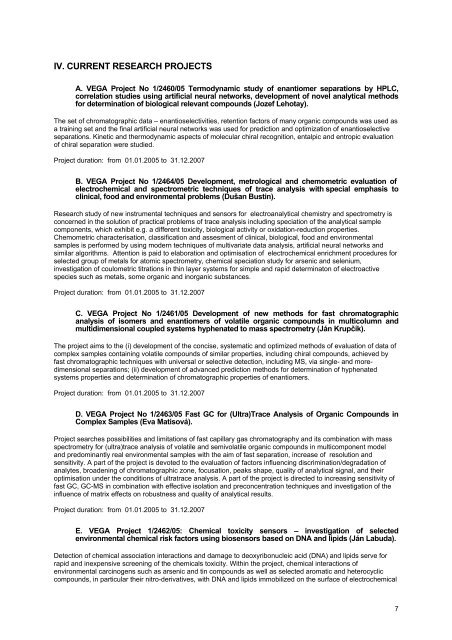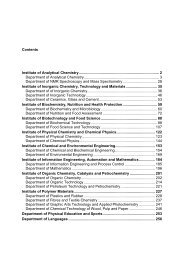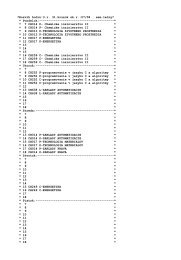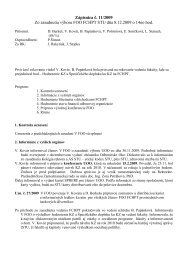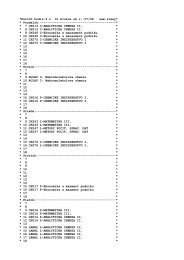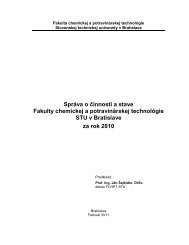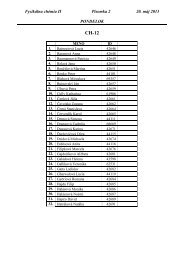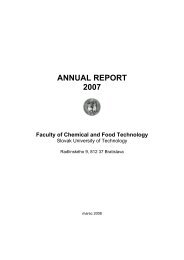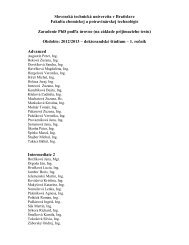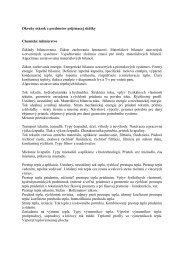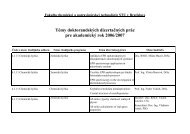rok 2006 - Fakulta chemickej a potravinárskej technológie ...
rok 2006 - Fakulta chemickej a potravinárskej technológie ...
rok 2006 - Fakulta chemickej a potravinárskej technológie ...
Create successful ePaper yourself
Turn your PDF publications into a flip-book with our unique Google optimized e-Paper software.
IV. CURRENT RESEARCH PROJECTS<br />
A. VEGA Project No 1/2460/05 Termodynamic study of enantiomer separations by HPLC,<br />
correlation studies using artificial neural networks, development of novel analytical methods<br />
for determination of biological relevant compounds (Jozef Lehotay).<br />
The set of chromatographic data – enantioselectivities, retention factors of many organic compounds was used as<br />
a training set and the final artificial neural networks was used for prediction and optimization of enantioselective<br />
separations. Kinetic and thermodynamic aspects of molecular chiral recognition, entalpic and entropic evaluation<br />
of chiral separation were studied.<br />
Project duration: from 01.01.2005 to 31.12.2007<br />
B. VEGA Project No 1/2464/05 Development, metrological and chemometric evaluation of<br />
electrochemical and spectrometric techniques of trace analysis with special emphasis to<br />
clinical, food and environmental problems (Dušan Bustin).<br />
Research study of new instrumental techniques and sensors for electroanalytical chemistry and spectrometry is<br />
concerned in the solution of practical problems of trace analysis including speciation of the analytical sample<br />
components, which exhibit e.g. a different toxicity, biological activity or oxidation-reduction properties.<br />
Chemometric characterisation, classification and assesment of clinical, biological, food and environmental<br />
samples is performed by using modern techniques of multivariate data analysis, artificial neural networks and<br />
similar algorithms. Attention is paid to elaboration and optimisation of electrochemical enrichment procedures for<br />
selected group of metals for atomic spectrometry, chemical speciation study for arsenic and selenium,<br />
investigation of coulometric titrations in thin layer systems for simple and rapid determinaton of electroactive<br />
species such as metals, some organic and inorganic substances.<br />
Project duration: from 01.01.2005 to 31.12.2007<br />
C. VEGA Project No 1/2461/05 Development of new methods for fast chromatographic<br />
analysis of isomers and enantiomers of volatile organic compounds in multicolumn and<br />
multidimensional coupled systems hyphenated to mass spectrometry (Ján Krupčík).<br />
The project aims to the (i) development of the concise, systematic and optimized methods of evaluation of data of<br />
complex samples containing volatile compounds of similar properties, including chiral compounds, achieved by<br />
fast chromatographic techniques with universal or selective detection, including MS, via single- and moredimensional<br />
separations; (ii) development of advanced prediction methods for determination of hyphenated<br />
systems properties and determination of chromatographic properties of enantiomers.<br />
Project duration: from 01.01.2005 to 31.12.2007<br />
D. VEGA Project No 1/2463/05 Fast GC for (Ultra)Trace Analysis of Organic Compounds in<br />
Complex Samples (Eva Matisová).<br />
Project searches possibilities and limitations of fast capillary gas chromatography and its combination with mass<br />
spectrometry for (ultra)trace analysis of volatile and semivolatile organic compounds in multicomponent model<br />
and predominantly real environmental samples with the aim of fast separation, increase of resolution and<br />
sensitivity. A part of the project is devoted to the evaluation of factors influencing discrimination/degradation of<br />
analytes, broadening of chromatographic zone, focusation, peaks shape, quality of analytical signal, and their<br />
optimisation under the conditions of ultratrace analysis. A part of the project is directed to increasing sensitivity of<br />
fast GC, GC-MS in combination with effective isolation and preconcentration techniques and investigation of the<br />
influence of matrix effects on robustness and quality of analytical results.<br />
Project duration: from 01.01.2005 to 31.12.2007<br />
E. VEGA Project 1/2462/05: Chemical toxicity sensors – investigation of selected<br />
environmental chemical risk factors using biosensors based on DNA and lipids (Ján Labuda).<br />
Detection of chemical association interactions and damage to deoxyribonucleic acid (DNA) and lipids serve for<br />
rapid and inexpensive screening of the chemicals toxicity. Within the project, chemical interactions of<br />
environmental carcinogens such as arsenic and tin compounds as well as selected aromatic and heterocyclic<br />
compounds, in particular their nitro-derivatives, with DNA and lipids immobilized on the surface of electrochemical<br />
7


